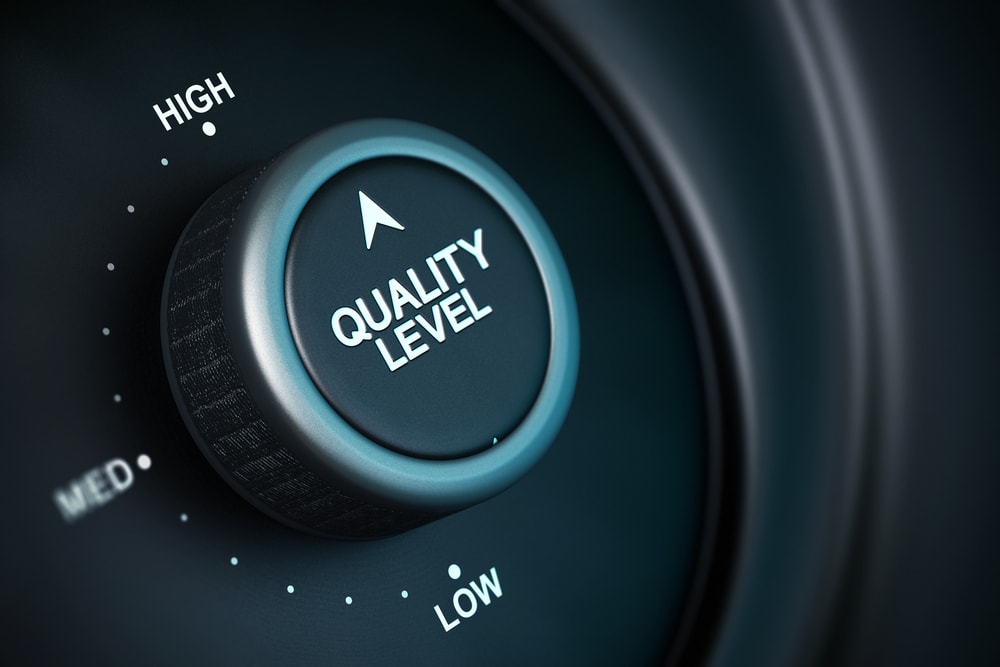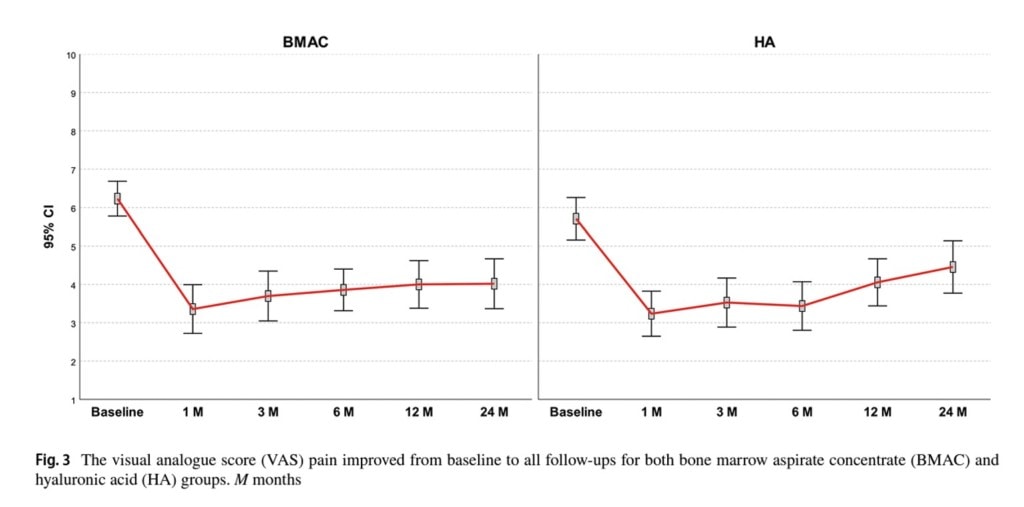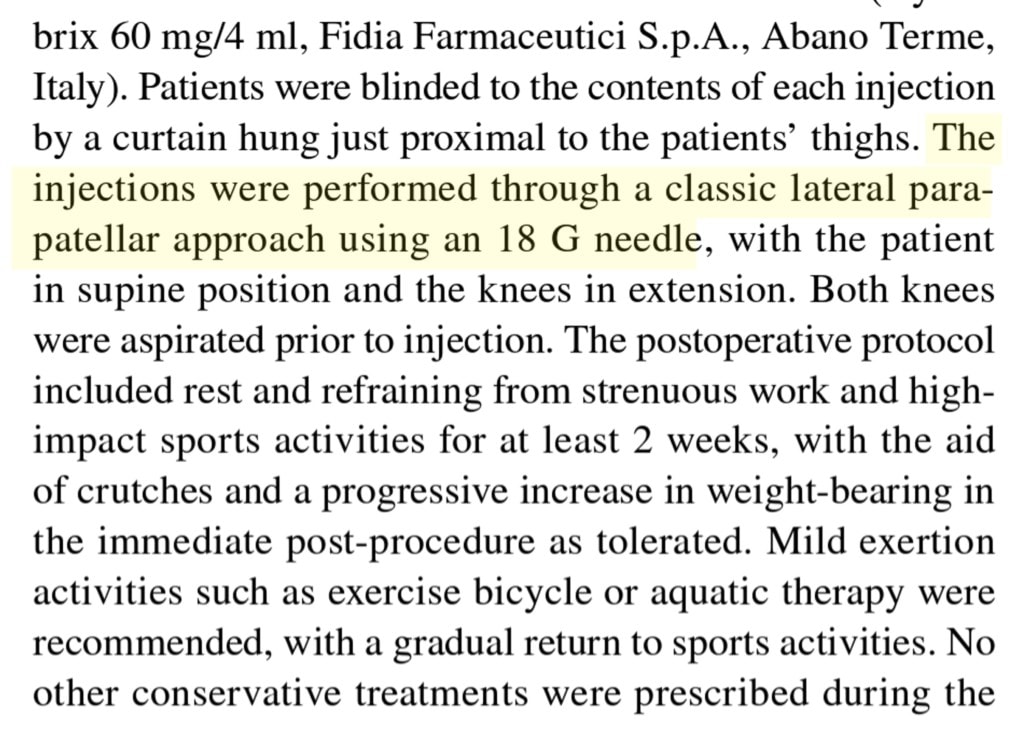What a New Bone Marrow Knee Study Can Teach Us About QA

Credit: Shutterstock
QA is a term that you hear more often in industries like manufacturing or engineering, not in medicine. However, the bone marrow concentrate procedure for knee arthritis has so many moving parts that QA is key. So today we’ll review a new research paper and also learn how they failed on several key QA metrics. Let’s dig in.
The New Research
This new study was performed by an experienced team of physicians in Italy who have published quite a bit on PRP (1). They randomized 60 knee arthritis patients with 56 knees getting intra-articular bone marrow concentrate (BMC) injections and 56 knees getting hyaluronic acid (HA). HA is also known as a knee gel shot and has been shown to be effective for treating arthritis (2). While the study has some issues that we’ll delve into a bit, overall it demonstrated what we would expect to see. The BMC and HA worked about the same for the early part of the study, but by the 1 and 2-year mark, BMC was performing better:

Given that in most patients, the problem with HA is that its effects don’t last that long and that in many patients it has diminishing returns on repeated injection, these results fit with what physicians see on a day-to-day basis. My guess is that if the authors had followed these patients for longer they would have seen even more differences, but all we have is two years’ worth of data.
The title is a bit misleading: “Bone marrow aspirate concentrate injections provide similar results versus viscosupplementation up to 24 months of follow-up in patients with symptomatic knee osteoarthritis. A randomized controlled trial”. Actually the BMC performed much better than the HA at 12 and 24 months, so the title should state that. Why?” Because some people will only ever read that inaccurate title.
Congratulating the Authors
First, before I get into any critique, the authors should be congratulated for adding to the evidence base for BMC knee injections. So a big “Thank-you” is warranted! This study took lots of time and resources as well as blood, sweat, and tears.
Learning about BMC QA by Dissecting this Study
While the results of this study were good enough, BMC seemed to slightly underperform relative to other studies out there. Could there be reasons? Yep. Let’s look at those issues to learn about BMC QA. First, we see this:

It’s what we don’t see here that’s the problem. What we see is that bone marrow was collected in two 30 ml syringes. What we don’t see is that the bone marrow aspirate was drawn from many sites in small amounts. The former method reduces stem cells yield based on multiple published papers (3-5). Hence, the BMC was hamstrung by what I call a “lazy draw”, meaning one that was convenient for the doctor but that left lots of cells in the bone marrow. Once the doctor got the BMA, it was thrown into a simple bedside centrifuge.
Here’s another example of something we don’t see, but should:

This was a BLIND injection into the knee with a HUGE needle. There is just zero justification in 2021 for not using ultrasound guidance to ensure you’re actually in the knee joint. There is also no justification to use a needle this big because if that size needle hits the cartilage, it causes damage. The needle we commonly use with this procedure is a 25 gauge or at most a 22, which is about 1/3 and 1/2 this size.
The other issue with not using ultrasound is the fact that if you inject blind, there is a percentage of the time that you will miss the joint altogether. Based on that data, about 1 in 5 of these knee joints was never actually injected with either HA or BMC (6,7). In addition, a recent study associated blind injection of HA with worse knee outcomes when compared to ultrasound-guided injection (8).
Finally, there’s another big problem with this study and again it’s with something that isn’t provided in the paper. Nobody ever bothered to measure the dose of the BMC being used! That’s not reported as a total cell count (TNCC) or as a CFU-f. Meaning, the authors had no idea of the number of cells being injected. That’s a problem as our research has associated higher cell count BMC knee injections with better outcomes and other studies have tied outcomes in other areas to CFU-f (9,10).
Regenexx QA
What do we do within the Regenexx network? Why do we have a network in the first place? We could just sell everyone a simple bedside centrifuge kit and turn them loose. Regenexx does the QA so that when you walk into a network site, you know you’re getting the best possible treatment. That of course won’t guarantee that what we do always works, but you at least know that we gave you the best possible chance of an orthobiologic procedure being effective.
So let’s look at what would have been done differently at a Regenexx site versus what they did in this paper:
- A better BMA. The doctor will draw your bone marrow aspirate from many sites in the bone, which will maximize the stem cell number in the sample. You won’t know the difference, but we will.
- Better processing. The doctor will process your cells in an in-house lab that can generally increase the concentration many times over simple bedside centrifuges like the one used here.
- A better injection. The doctor will use ultrasound guidance to make sure he’s in your knee joint.
- Counting the cells. The doctor’s office will count the total cells and the doctor will use that number to help improve your outcome. For example, should I inject one knee or two based on the cell yield from the BMA?
If for some reason you don’t get all of this, then the final part of QA is accountability. Please email me at my desk at centenooffice@centenoschultz.com.
The upshot? While it’s always great to have yet another paper on BMC and this one did show that BMC was superior to HA at 1 and 2 years, it did have some problems. Meaning, the things that should have been done to maximize the outcome of BMC weren’t done. However, by reviewing these problems, you can learn how QA for BMC should be done!
______________________________________________
(1) Boffa A, Di Martino A, Andriolo L, De Filippis R, Poggi A, Kon E, Zaffagnini S, Filardo G. Bone marrow aspirate concentrate injections provide similar results versus viscosupplementation up to 24 months of follow-up in patients with symptomatic knee osteoarthritis. A randomized controlled trial. Knee Surg Sports Traumatol Arthrosc. 2021 Nov 12. doi: 10.1007/s00167-021-06793-4. Epub ahead of print. PMID: 34767030.
(2) Rutjes AW, Jüni P, da Costa BR, et al. Viscosupplementation for Osteoarthritis of the Knee: A Systematic Review and Meta-analysis. Ann Intern Med. 2012;157:180–191. doi:10.7326/0003-4819-157-3-201208070-00473
(3) Batinić D, Marusić M, Pavletić Z, Bogdanić V, Uzarević B, Nemet D, Labar B. Relationship between differing volumes of bone marrow aspirates and their cellular composition. Bone Marrow Transplant. 1990 Aug;6(2):103-7. PMID: 2207448.
(4) Muschler GF, Boehm C, Easley K. Aspiration to obtain osteoblast progenitor cells from human bone marrow: the influence of aspiration volume. J Bone Joint Surg Am. 1997 Nov;79(11):1699-709. doi: 10.2106/00004623-199711000-00012. Erratum in: J Bone Joint Surg Am 1998 Feb;80(2):302. PMID: 9384430.
(5) Fennema EM, Renard AJ, Leusink A, van Blitterswijk CA, de Boer J. The effect of bone marrow aspiration strategy on the yield and quality of human mesenchymal stem cells. Acta Orthop. 2009 Oct;80(5):618-21. doi: 10.3109/17453670903278241. PMID: 19916699; PMCID: PMC2823327.
(6) Bum Park Y, Ah Choi W, Kim YK, Chul Lee S, Hae Lee J. Accuracy of blind versus ultrasound-guided suprapatellar bursal injection. J Clin Ultrasound. 2012 Jan;40(1):20-5. doi: 10.1002/jcu.20890. Epub 2011 Oct 28. PMID: 22033897.
(7) Fang WH, Chen XT, Vangsness CT Jr. Ultrasound-Guided Knee Injections Are More Accurate Than Blind Injections: A Systematic Review of Randomized Controlled Trials. Arthrosc Sports Med Rehabil. 2021;3(4):e1177-e1187. Published 2021 Jun 26. doi:10.1016/j.asmr.2021.01.028
(8) Lundstrom ZT, Sytsma TT, Greenlund LS. Rethinking Viscosupplementation: Ultrasound- Versus Landmark-Guided Injection for Knee Osteoarthritis. J Ultrasound Med. 2020 Jan;39(1):113-117. doi: 10.1002/jum.15081. Epub 2019 Jun 25. PMID: 31237389.
(9) Centeno CJ, Al-Sayegh H, Bashir J, Goodyear S, Freeman MD. A dose response analysis of a specific bone marrow concentrate treatment protocol for knee osteoarthritis. BMC Musculoskelet Disord. 2015 Sep 18;16:258. doi: 10.1186/s12891-015-0714-z. PMID: 26385099; PMCID: PMC4575428.
(10) Pettine KA, Suzuki RK, Sand TT, Murphy MB. Autologous bone marrow concentrate intradiscal injection for the treatment of degenerative disc disease with three-year follow-up. Int Orthop. 2017 Oct;41(10):2097-2103. doi: 10.1007/s00264-017-3560-9. Epub 2017 Jul 26. PMID: 28748380.

NOTE: This blog post provides general information to help the reader better understand regenerative medicine, musculoskeletal health, and related subjects. All content provided in this blog, website, or any linked materials, including text, graphics, images, patient profiles, outcomes, and information, are not intended and should not be considered or used as a substitute for medical advice, diagnosis, or treatment. Please always consult with a professional and certified healthcare provider to discuss if a treatment is right for you.
